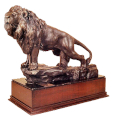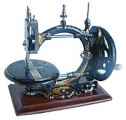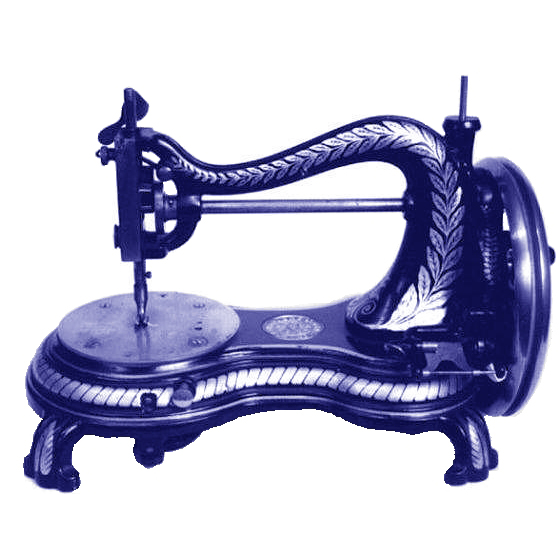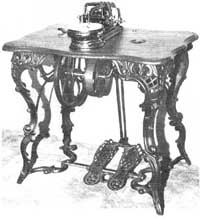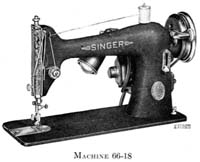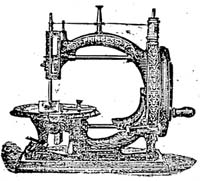Some Thoughts on Family Machines
ISMACS News
Issue 41
SEWING MACHINES, like many types of machinery, fall into two classes.
There are the classic designs which are well engineered, intelligently marketed to fulfill a need and which are made by the million, and there are the engineering abortions, often fraudulently marketed which die and are almost lost from view.
Pre-eminent in the first group is the Singer "New Family" machine of 1865, whilst the second group contains many machines such as the Moldacot, the Dorman, etc, which are collectable because of their rarity.
The display of family-type machines at the Milton Keynes meeting reminded us that the great impact of the sewing machines at home and at work derives from the first group and not the second.
The first large-production machine was the Wheeler & Wilson curved-needle machine which was widely copied all over the world (eg the Frister & Rossmann A1, the Whight & Mann "Alberta", the Bradbury "Belgravia", the Britannia, etc).
Singer's first attempt at a small "Family" machine in 1858 looks a bit like a shuttle version of the Wheeler & Wilson curved-needle machine. It is about the same size. The Singer "Family" was not a commercial success.
Its successor, the transverse shuttle Letter A, was a much better machine which was re-designed and launched as the "New Family" in 1865.
This wonderful machine (the type 12, or 12 K - for Kilbowie - in Britain) was to remain in production by Singer until after 1900, by which time an estimated two million had been made world-wide.
The "New Family" had a big brother (the "Medium" or 18K) which used many of the same parts but had more room under the overarm to suit dressmakers and tailors.
So dominating did this machine become that it was very widely copied by competitors, all of whom had their Family and Medium machines which used parts interchangeable with the Singer machines.
When the Singer patents ran out the copies were even advertised as "Singer system" to confuse the customer - see the Davis advertisement. These copies continued to be made until the 1930s.
Singer always used the "fiddle" - violin-shaped - base while competitors changed to rectangular bases after about 1900.
Singer did produce a revised rectangular-based Family (the 48K) around 1902 using a torpedo shuttle; it was not a success.
In the period 1886 to 1890 the Singer Company produced two further classic designs for the domestic market. First was the vibrating shuttle No. 2 (later 27K and 28K) using a torpedo shuttle moving in an arc parallel to the cloth feed.
The second was the type 15K oscillating-shuttle machine whose mechanism lives on today in most of the present generation of budget machines.
Just as the "New Family" mechanism had been widely copied, the Singer vibrating shuttle (VS) machine was made by all and sundry. Singer itself made its last batch in 1964.
Singer was not the only manufacturer whose products were plagiarised. Wheeler & Wilson suffered it initially with its curved-needle machine and subsequently with the excellent D9 whose copies were usually known as "spool" or "family-rotary" machines. Copies of the Willcox & Gibbs chain-stitch machine are also common.
Here are some points of interest in this area:
1. Everyone with an interest in the sewing machine ought to have a Singer "New Family", so look out for one.
2. The decoration of the machines reflects changes in fashion. Since family machines were in production for a long time, examples occur with mother-of-pearl decoration, Victorian daisies, art nouveau flowers, art deco flowers and motifs, Egyptian sphinxes, etc. A history of fashion could be a theme for a collection.
3. The sewing-machine industry was an early user of "badge engineering". When a distributor bought 100 or more machines, the manufacturer would "badge" them with the distributor's name and/or trademark. This was particularly true of imported German machines. Find out who had badged machines in your area.
4. Some manufacturers did try to break away from slavish copying of established classics. One such was Job Davis (Watertown, Conn, USA) who fitted an ingenious and workmanlike top feed (he called it a "Vertical Feed") to a basic vibrating-shuttle machine.
Bradbury produced a clumsy rotary-shuttle machine in addition to Family and VS machines. Domestic produced an interesting variant of the vibrating-shuttle machine. There are many, many others.
5. Just as the Medium was an enlarged Family, several manufacturers made 3/4-sized machines (eg the Winselmann "Titan"). A collection of these takes up less space and weighs less!
6. Mounts for the machines are many and various. They come on cast-iron bases with or without sheet-metal covers for tropical use (termite proof!).
Most common are those on wooden bases though, even here, there is a wide range from basic varnished beech and plywood to walnut veneer with inlaid rules and decoration. Nearly all were available on treadle mounts.
Here the choice varied from a simple table on a cast-iron frame, though the "drophead" (in which the machine is hinged so as to be stored below the top surface) to the complete hardwood-veneered cabinet fit to grace a mansion.
7. Attachments. Most machines came with a box full of attachments: hemmers; quilters, corders; rufflers; guides, etc. Although they are often described in the instruction book most look unused.
Here is a fertile area for research as I know of nothing published on them and yet many have been around almost as long as the machines for which they were supplied.
